#chapelle st jean
Explore tagged Tumblr posts
Text

Carrières-sur-Seine, la chapelle St-jean.
#Carrières-sur-Seine#banlieue#banlieue parisienne#architecture#retro géographie#trente glorieuses#urbanisme#brutalisme#chapelle st jean
147 notes
·
View notes
Text

Villefranche Sur Mer, Chapelle St. Pierre
Jean Cocteau
lithograph printed in colors, 1957
12 notes
·
View notes
Text

Cimetière de Montmartre - Paris (France)
Vitrail de chapelle mortuaire signé J Vantillard -
Charles Joseph Vantillard est un maître-verrier français, né à Moncel-sur-Seille (Meurthe-et-Moselle) le 19 mars 1836 , et mort à Paris le 10 novembre 1909.
#vitrail#Cimetière Montmartre#J.Vantillard#“maître verrier”#St-Jean-Baptiste#léonard de vinci#chapelle mortuaire#photo oedelaberg
1 note
·
View note
Text

Jean Auguste Dominique Ingres, Saint Raphael Archangel, Cardboard for the windows of the Chapel of St. Ferdinand, 1842
78 notes
·
View notes
Text
Ergo Proxy Opening: In search for the artwork's source
Ergo Proxy's Opening is a fascinating piece of artwork characterized by it's kaleidoscopic mix of scenery, images from the series and subtle references to pieces of art and literature. The whole design reminds me a bit of the style of Kyle Cooper in intro sequences like Se7en . Some are very clear while others are quite cryptic and frankly unreadable. This post will summarize a few of those references and their sources:
Holy Images

First we have the apparition of some glass panels and a statue in a column, and the image of some industrial complex. The statue have a chalice and appears to be a young man, and an eagle at his feet. Those are the attributes of Saint John the Younger. With that in mind, the search was easier... and after almost 14 hours of reading and searching, I found two of the three artworks.
Both the statue and the stained glass comes from the The Cathédrale Saints-Michel-et-Gudule at Brussels.
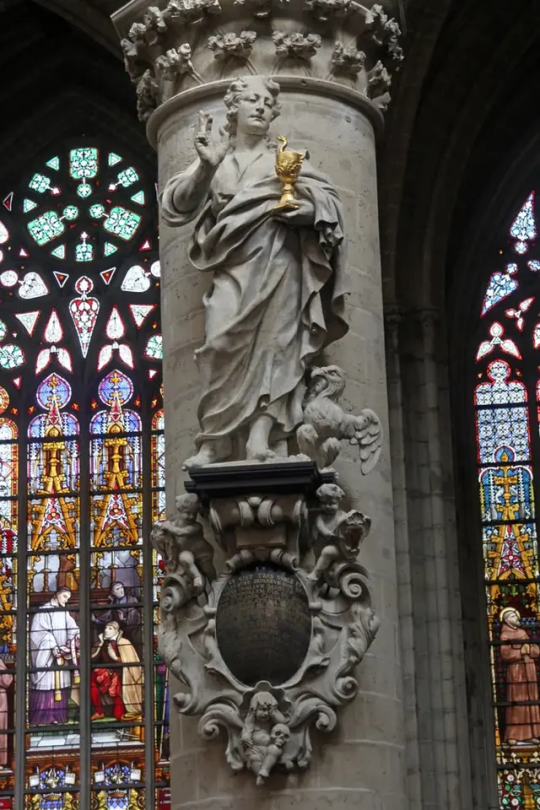
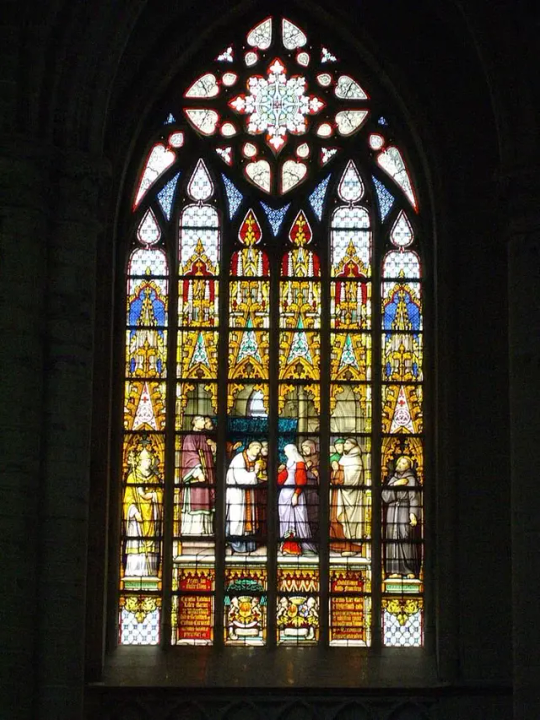
Stained Glass, probably made by Jean-Baptiste Capronnier (c. 1870):

Another decorated window appears, this time with a more modern artwork. The decorated window was designed by Alfons Mucha, c. 1930, for the reconstruction work for St. Vitas Cathedral in Prague.
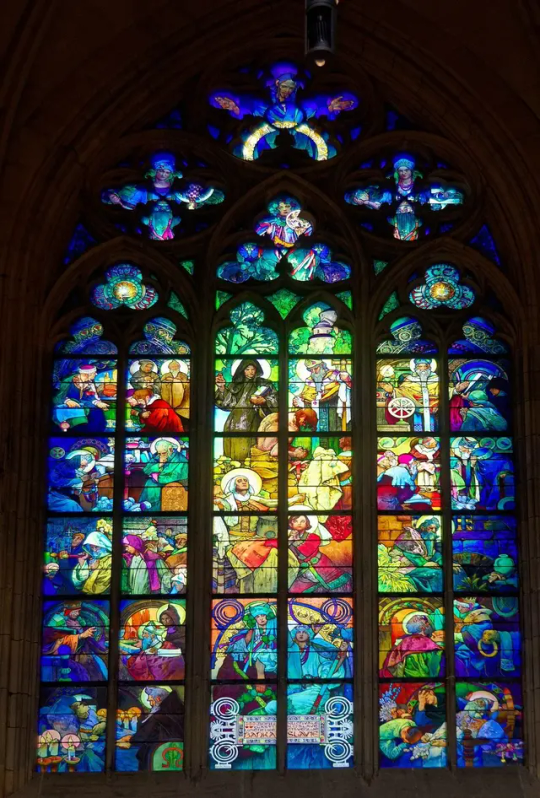
The Power of Seven and the Lapis Philosoficus
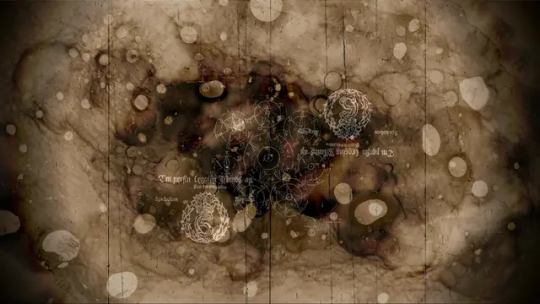
The occasional image of complex astrological or alchemical heptagrams flashes many times during the opening, being this one the most clear snap I could get. The text in the center of it reads "Ma Te Ri A Pri Ma *" that confirms the alchemical nature of the illustration.
After many attempts to find the source of the illustration i had to dive into my older alchemy notes. Suddenly I remember the works of a notorious alchemist obsessed with number seven, none other than Sir Isaac Newton. And Eureka!
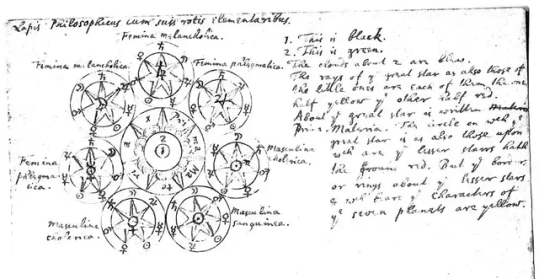
the image comes from a set of notes on the processes behind the achievement of the philosopher's stone, titled "Lapis Philosophicus cum suis rotis elementaribus" and dated to c. 1690
Landnámabók
Some of the decorations that appears on the opening comes directly from the icelandic text of settlers, a medieval Icelandic written work which describes in considerable detail the settlement (landnám) of Iceland by the Norse in the 9th and 10th centuries CE.


La Glorification de l'Art
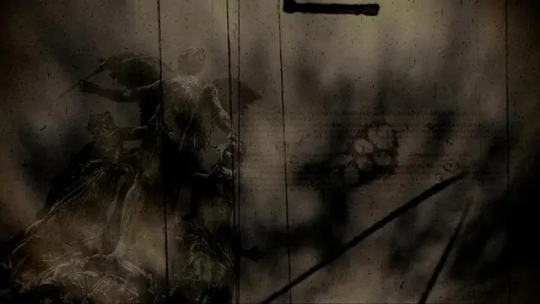
This one was relatively easy to find. It is a quite common allegorical representation.

The building housing the Royal Museum of Ancient Art in Brussels is a masterpiece designed by Alphonse Balat, the Court's favorite architect, the sculpture flanking the main entrance is the work of Paul de Vigne, and was made around 1885. La Glorification de l'Art depicts Art as a winged youth, accompanied by Glory and Fame. It also appears on the opening. Art, represented by a winged man, receives from the hand of Glory a palm and a crown; while the Fame, with trumpet and bumper, publishes her exploits.
Rhyme 247

notice the words on the right side of the screenshot: "e vero", "Non Veder" "Gran Ventura"
Michelangelo Buonarroti was an exceptionally good artist, and a passionate poet too, even when he preferred to keep most of his literary production quite obscure. One of his works for the Sagrestía Nuova at the Medici Chapel in Florence was a representation of the Night, placed over the tomb of Giuliano di Lorenzo de' Medici, Duke of Nemours. Night was singularly praised by his contemporaries, especially Giovanni Strozzi, who dedicated an epigram on 1544:
La Notte che tu vedi in sì dolci attidormire, fu da un Angelo scolpitain questo sasso e, perché dorme, ha vita:destala, se nol credi, e parleratti.
Michelangelo responded in another epigram, today known as Rhyme 247:
Caro m'è 'l sonno, e più l'esser di sasso,mentre che 'l danno e la vergogna dura;non veder, non sentir m'è gran ventura; però non mi destar, deh, parla basso
This Rhyme appears on Ergo Proxy in another occasion:

The poem as appears on the beginning of the first episode
NIGHT DAWN DAY DUSK
Donov Mayer's Collective Entourage are embodied by the four sculptures from the allegorical monument (Sagrestía Nuova) of Michellangelo. A pair of the statues were located over the sarcophagus of Giuliano de' Medici, (Day and the Night) and Lorenzo de' Medici (Dusk (or Twilight) and the Dawn) respectively. On the series, each have the name of one prominent occidental philosopher:
Lacan: as Night, Voiced by: Atsuko Tanaka (Japanese), Barbara Goodson (English)
Derrida: as Dawn, Voiced by: Yōko Sōmi (Japanese), Melodee Spevack (English)
Husserl: as Day, Voiced by: Hidekatsu Shibata (Japanese), Michael McConnohie(English)
Berkeley: as Dusk, Voiced by: Yuu Shimaka (Japanese), Doug Stone(English)

[Unknown]
Some artworks or pieces of literature used are still unknown (for me)

The industrial landscape
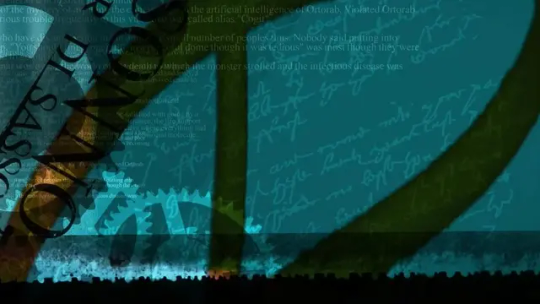
The cursive text

And this arabic/persian texts
Thank you so much for reading so far
8 notes
·
View notes
Text
Jess Piper at The View from Rural Missouri:
Meet Pastor Josh Blevins of Grace Calvary Chapel in St Joseph, Missouri. He says his mission is: Awakening people to the love, truth, and power of God, however, his actions say that he is anti-LGBTQ, anti-democracy, and anti-woman. He seems to be pro-consolidating power through local and state politics. Let me introduce you to the term TheoBro:
[A group of young pastors hope to spearhead a Christian nationalist glow-up as they eagerly await a “Christian prince” to rule America. These often bearded thirty- and forty-somethings have suits that actually fit. They are extremely online, constantly posting on myriad platforms, broadcasting their YouTube shows from mancaves, and convening an endless stream of conferences for like-minded followers. Let’s call them, as one scholar I spoke with did, the TheoBros.]
Pastor Josh Blevins certainly falls into the TheoBro category. He often preaches in skinny jeans, a plain white tee shirt, and Blundstone boots. He sports a beard and comes across as witty and relevant with online quips and trends. He is on every social media app you can name and regularly posts content. He seems cool…not like those other preachers. He is the definition of a TheoBro. You may think this new brand of preacher would be a little more liberal or tolerant but you would be wrong. I first heard of Pastor Blevins when he and his church started meddling in local politics — St Joseph is only about 45 minutes south of me, so I know most of the players. I started paying attention when his church, Grace Calvary Chapel, started trying to fill school board positions with parishioners.
This church was also involved in a campaign to ban books from St Joseph Public School libraries. They lost. It got worse. Pastor Blevins went after another pastor, Brian Kirk. Kirk is the pastor of First Christian Church and was on the City Library Board for a decade — he is also gay. Brian didn’t pick out or approve library books; he regularly worked on making sure the steps into the library were ADA compliant and made recommendations for building repairs. It’s kind of a boring job that someone needs to do and Brian did it with passion and commitment. Brian Kirk was ultimately removed from the Library Board in 2023 after a decade of service because he is gay. Yes, you read that right. He was removed from a city position because he is gay. Guess who worked with the City of St Joseph to have Pastor Brian Kirk removed? Pastor Josh Blevins. Blevins stated, “We are against the practice of homosexuality. Part of the grooming is normalizing sinful behavior in the culture.” His bigotry helped oust Pastor Kirk.
You’ll be pleased to know that Pastor Brian Kirk has filed suit against Pastor Blevins. [...] Bringing in pastors to do the work of politicians is as old as time. Before and during the Civil War, Southern pastors regularly preached on the necessity of slavery and the benevolence of the plantation class. They preached on the evils of the “atheist northerners.” Not much has really changed since then. The Confederates became MAGA. And just like poor white folks took up the Lost Cause to protect the oligarchs during the Civil War, the poor white folks of this century have taken up the cause of protecting the wealth of the current oligarchs. Preachers have always been indispensable in reminding their congregants that they may have to suffer as a martyr in this life…their reward will be in the next. This is exactly the type of thinking the oligarchs hope we all embrace.
Jess Piper wrote this pithy piece on her Substack the dangers of TheoBros and Christian Nationalism’s influence from the pulpit.
9 notes
·
View notes
Text
"Margaret (of York, Duchess of Burgundy) left Bruges on 24 June and was in England for more than three months. She travelled with a large retinue headed by Guillaume de Baume and the embassy included two officials who were well-known to her, Thomas Plaines and Jean Gros, the treasurer of the Order of the Golden Fleece. She received aides from the Estates to cover her expenses with the Hainault Estates contributing 4,000 livres. Her mission had several goals, but the immediate need was to obtain some military help in the form of English archers to reinforce Maximilian’s hard pressed armies. ... King Edward sent Sir Edward Woodville, the Queen’s younger brother, aboard the royal ship ‘Falcon’ to bring his sister across the Channel. It was twelve years since she had sailed to her marriage. Sir Edward had been part of her marriage party and he had won the honours in the famous joust of the Golden Tree. This time Margaret took the shorter route from Calais to Gravesend, where she was received by Sir John Weston, the Prior of the Knights of St John. She then transferred to a royal barge which had been sent to bring her up the Thames to London. The barge was specially refitted for the occasion. The master and the twenty-four oarsmen had been supplied with new liveries in the Yorkist colours of murrey and blue with white roses embroidered on their jackets. The knights and squires who formed the escort of honour wore fine black velvet jackets which were decorated with a pattern of silver and purple. Two residences had been prepared for Margaret’s use, the palace at Greenwich where she had spent so much time before her marriage, and the London house of Coldharbour near her mother’s home at Baynard’s Castle. New beds with red and green hangings had been sent up to the Coldharbour house and the finest bedlinens and coverlets had been ordered. Curtains, screens and tapestries were provided for both the houses, including a piece of arras which depicted the story of Paris and Helen. For her travel during her stay in England, Margaret was sent ten ‘hobbeys and palfreys’ all newly harnessed and caparisoned in rich saddle cloths. The King encouraged everyone to be generous towards his sister and used ‘right large language’ with the Archbishop of Canterbury who failed to offer Margaret a gift. His own final present to his sister was a luxurious pillion saddle in blue and violet cloth of gold, fringed with ‘Venetian gold’ thread.
While she was in England, Margaret renewed her contacts with all her old friends and family. She was received by the Queen and introduced to her royal nephews and nieces. Her youngest brother Richard, Duke of Gloucester, who was busy dealing with Scottish incursions in the north, made time to come south to see his sister, and the King gave a state banquet at Greenwich in honour of Margaret and their mother, the old Duchess Cecily. It was also attended by Margaret’s sister Elizabeth, Duchess of Suffolk. It seems that Margaret admired the wine, for on the day after the banquet, Edward sent her ‘a pipe of our wine’ valued at 36s 8d. As well as enjoying the company of her living family, Margaret could not have failed to remember all her dead relations. It was perhaps with a chantry in mind that she persuaded Edward to introduce the reformed Order of the Observant Friars into England. Soon after her departure the King sent for the Vicar-General of the Order and offered him a site for their new monastery near to the palace of Greenwich. Building began in 1482 and the abbey chapel was dedicated to the Holy Cross. Was the dedication in honour of Margaret, and does it provide further evidence of her connection with Waltham Abbey? ... Well satisfied that the negotiations were at last completed, Margaret prepared to leave London. She paid a farewell visit to the city where she was presented with a purse containing £100. She then set off for the coast accompanied by her brother Edward who had decided to see her on her way. ... The Dowager passed a week in Kent visiting the shrine of St Thomas à Becket and staying on the private estates of Anthony Woodville, Lord Rivers. These two bibliophiles must have had much in common especially now that Rivers was the patron of Margaret’s former protégé, William Caxton. No doubt she was shown Woodville’s translation of the ‘Dictes and Sayings of the Philosophers’ which was one of the first books printed on Caxton’s press at Westminster. With the King still in attendance, Margaret finally left for Dover, where the ‘Falcon’ waited to take her back to Calais. Edward seemed to be genuinely sad to see her departure and he wrote to Maximilian on 22 September announcing the return of his ‘well-beloved sister’. She left behind her in England Jacques de la Villeon, who was to act as an agent for the Burgundian ally, the Duke of Brittany."
Christine Weightman, "Margaret of York: The Diabolical Duchess"
#historicwomendaily#margaret of york duchess of burgundy#margaret of york#margaret of burgundy#15th century#english history#my post#everyone knows about the politics. let's focus on the personal#also there's a misconception that she and edward were estranged after clarence's death#i really don't think that's true
20 notes
·
View notes
Text




On May 19, 1956, Jean Kennedy married businessman Stephen Edward Smith in the Lady Chapel of St. Patrick's Cathedral, New York.
Newlyweds Jean Kennedy Smith and Stephen E. Smith on their wedding day❤️
31 notes
·
View notes
Text
French Kiss: Tale of the Revolution, Ch. 20: Happy Endings
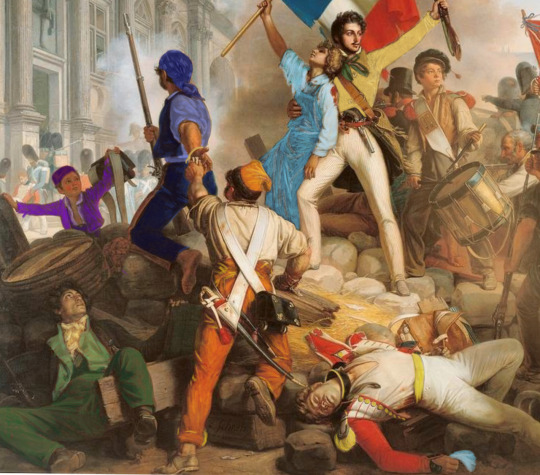
Colorized version of Fighting at the Hotel de Ville, 28th July 1830 by Jean Victor Schnetz. (embedded image description)
Prev - Happy Endings - Masterpost - [ AO3 ]
Summer, 1830, Café Procope
Virgil leaned forward, elbows on the table, and he watched, eyes wide, as the bearded man took a long draw on his coffee. “Then what happened? Tell me, did Patton and Remus free them? Did they… did they go back for Logan’s body? Maybe… maybe he was really still alive?”
The bearded man’s eyes shot over to the bartender, but his back was turned to them.
“Patton didn't slept at all that night,” the bearded man shook his head. “Remus tried, if for no other reason than to mollify him. And to…" He lowered his voice. "Give him a little privacy while he grieved." The bartender faced the other side of the bar, studiously busy polishing a beer stein. The bearded man cleared his throat and nodded. "At first, Remus imagined making his way back to the palace, fighting and sneaking his way past the rebels, convincing the guards he was who he said he was, and breaking in to free his love and his brother.”
He drank more of his coffee. “But as the night wore on, the fires at Versailles grew brighter. And his hope dimmed.”
15 July 1789
Patton stirred at the first hint of pink along the horizon. “Your—Remus?” he whispered, moving closer and resting a hand on Remus’ shoulder. “Are you awake?”
“Yes,” his voice cracked. Patton was on his feet, stomping dirt into the embers. Remus scrambled up after him. “The horses stayed,” he murmured.
“Petit and Naif are good horses, aren’t you?” he cooed, scritching across the shorter one’s back before strapping down his saddle.
“So you’ll take Petit,” Remus copied his movements and buckled the other saddle. “And I’ll take Naif?”
Patton chuckled dryly. “Petit’s the taller one. You’ve got her now." He stroked Naif's mane and his voice went soft. "Logan used to pretend he didn't like that joke.” He dragged his hand across his face and watched the sun inch her way over the horizon. Remus lifted his hand, about to grip his shoulder or… Do something. Anything. Anything to cut through the blanket of grief wrapped around the other man.
But Patton straightened and pointed to the thinnest part of the trees. “We’ll head that way on foot, then see how the road looks.” He nodded and clicked his tongue. Both horses followed him. “With any luck, we can ride most of the way.”
~~~
The City of Light burned.
Black, oily smoke billowed from the Bastille and several of the larger estates along the far shore of the Seine. The tall, windowed doors of St. Germaine were barred with a crooked iron brace. There were scorch marks on the doors and more on the loose pages from the prayer books gathered in clumps along the gutters.
They walked the horses slowly, and Patton clucked soothingly when a loud bang sounded north of La Chapelle. “Welcome to Paris,” he murmured to Remus. The bright sunshine illuminated every cracked window, every pile of trash, every dirty puddle. Every beggar. Patton took them past du Foy, but Remy had boarded up the windows and was likely hunkered down inside, his stolen musket by his side, lead pipe in his hand. Remy had told him stories of the food riots in the '70s, and he was not the type to take chances after that.
A rumbly wave of voices spread out from the center of the city and they followed the noise. A large gallows had been assembled in the middle of Jardin Square. The air was thick and acrid with the fires dotting the city and July’s heat already rising up from the cobblestone streets. The memory of the forest's cool air and the babbling creek seemed unreal.
The gallows platform was empty save for a pair of rebels fastening nooses to the heavy beam. Either end was rough and splintered, probably plundered from one of the estates before the structure was torched. “Look,” Remus tugged at his sleeve and his eyes darted over to the floor of the gallows. It was built tall, with the stage higher than eye level. “There are trap doors.” Patton looked and under each rope was a jagged square. “If we can stop those from triggering, it could buy us time to cut them down.”
Patton nodded. “Let’s tie off the horses, then cover me while I get under there.”
Less than an hour later, Patton and Remus mingled with the crowd at either edge of the gallows, mere paces from the steps leading up to the stage. The moment the doors failed to open, they would rush up, clad in red scarves, and promise to help. They had to be fast, and cut the ropes before anyone else could reach them.
They had one shot.
Remus fidgeted, his curls, even dirty, bouncing as he shifted. He jumped when someone clapped his shoulder, laughing. He laughed along and said something Patton couldn’t decipher from the other end of the stage. A little boy beat out a steady rat-tat-tat on a dented drum and the crowd’s volume grew. The mass of people moved as one, breathless and faces bright with excitement. One of the Garde Royale emerged from the commandeered shop behind the gallows. His uniform was torn, epaulets ripped from the shoulders and a deep purple bruise covering one eye. The crowd jeered as he was led to the end closest to Patton and two students he recognized from the café tightened the noose around his neck.
More boos erupted from the men and women and children gathered around the stage. Janus stumbled out, eyes downcast and his hands tied in front of him, like the guard. He didn’t appear to be in as bad of shape, but he favored his left leg as he walked and he moved far too slowly. Remus’ eyes were fixed on him and he inched a little closer to the steps.
“Not too soon, Your Majesty,” Patton whispered under his breath, willing Remus to remember to wait.
Patton didn’t think the crowd could get louder but a flash of green drew a roar from the mob. A head taller than the men leading him, Prince Roman walked with shoulders squared and chin tilted up. If it weren’t for the split, bloodied lip and his blood-matted hair, he could have been making his entrance at a grand ball. He didn’t react when one of the men tried to trip him, catching himself before falling on his face, arms tied behind his back, one final loss of freedom they could inflict before at last taking away his life.
From where he stood, Patton could see the lever that was meant to open the hatches. Beneath the stage, he'd jammed thick cedar shims into the mechanisms, his sabotage invisible from the outside. The lever would work, but the hatched would remain closed just long enough for him and Remus to cut everyone down.
The drums intensified, riling up the crowd until there was a crack of gunpowder and the executioner pulled the lever. When the hatches didn’t open, panicked voices rose up from the students who’d squeezed through the crowd to get a better view of the hanging. They were now penned in, caught between the head-high hanging platform and the growing mob.
It was now or never.
Moving as one, Remus and Patton dashed onto the stage. Before Remus could reach his brother, the shim splintered and the hatch dropped beneath his feet. Remus shouted, a wordless, panicked cry, as he dragged Roman back up and began to hack at the rope. While that was going on, the guard had managed to wiggle one hand out from his ropes and freed himself before he abandoned his distinctive coat and jumped off the back of the execution stage. The crowd was stunned, and time seemed to stand still as Patton ran to Janus’ side.
With all eyes on the “King,” he sawed through Janus’ ropes and half ushered, half carried him to the other end of the stage. “Trust me,” he hissed at the twins, then ripped open Roman’s tattered green coat and shouted, “Everyone! Faites attention! He’s wearing red! The King’s a fraud, he’s just a guard." He pointed behind the stage, away from where the guard had escaped. "That man was the King!”
The mob roiled around them, a bubble waiting to pop. As they moved down the ladder, Remus spotted a familiar young woman dressed in rags, clutching her elderly grandfather’s arm. Her rough woven skirt and apron, stained and threadbare blouse looked like anyone else's but he knew that face. Relief flooded his heart and he almost smiled. Philomene! She’d gotten out and taken Maitre with her. She met Remus' eyes, bowed her head, then stepped in front of a rebel attempting to get to the stage. She grabbed his arm, speaking quickly and pointing to Maitre.
“Get to the horses while they’re distracted,” Patton ordered, pulling the princes along. He squirmed through the crowd as they pushed their way around the stage, hunting for the long-gone guard. Dirtied and bloodied, friend and foe, royalty and Jacobin all looked alike and they managed to get to the edge of the square where Petit and Naif nickered nervously.
“You found me,” Janus slurred once they’d stopped, hanging from Remus’ arm.
“Of course I found you, mon douceur,” he murmured and lifted Janus up into the saddle before climbing up behind him, one arm wrapped around his love’s waist, the other hand tight on the reins. “I promised you, ‘til my last breath and beyond.” He nuzzled gently against the side of his neck, shoulders trembling. After a moment, he straightened and turned toward the others. “Race you, brother,” he started to laugh, but it came out more like a sob at the sight his brother’s bruised and bloodied face.
“If you think I’m going to let you win merely because you saved my life,” Roman’s smile was weak but real as he mounted the other horse behind Patton. “You’re dreaming.”
Patton chuckled at the brothers’ banter and tugged on the taller man’s arms. “Hold on tight, Your Highness” he muttered.
“Mon héros petit,” he said quietly, both arms looped tightly around Patton’s waist. He looked over his shoulder when the sound of the mob changed. Someone in the crowd pointed their way, and the mob seethed, undulating toward them like some giant sea creature.
“We need to move,” Patton said, clicking his tongue at the horses. “Now!”
Urging Naif and Petit into a gallop, the four of them took off just ahead of the crowd, leaving the chaotic mob in their horses’ dust.
Summer, 1830, Café Procope
“Mon dieu,” Virgil murmured. “They made it?” Tears pouring freely down his cheeks, he accepted a handkerchief from the bearded man. He scrubbed his face dry and shook his head. “That was a beautiful story, monsieur. Thank you.” He swallowed hard and nodded. “Where are they now? The stories say they—”
“Last I heard, the four of them were still guests of King Fredrick in Berlin.” He shrugged and finished his coffee. “Exile beats death.”
Virgil tapped the sides of his cup and leaned forward, eyes drawn to the gun the bearded man still held. His gun. “Did Patton ever return to Paris to seek revenge? To find… um… Raúl?" He stared at his gun with hardened eyes before looking up at the bearded man. "Make him pay for killing Logan?”
Shaking his head, again the bearded man gazed out at the bartender working his way through his closing tasks. The bar counter gleamed in the lamplight, every glass shone, bright and glossy. Just like the bartender’s clear blue eyes. “Patton was never the type to hurt someone out of revenge.” He returned his attention to Virgil. “Besides, they all knew Logan wouldn’t’ve wanted that.”
The dark fire that had filled Virgil’s eyes faded, and the coffee had sobered him. He stared down at the table for a long time, rubbing his hands over the scarred but polished surface. Finally he looked up and jerked his chin toward the gun. “I listened to your story, monsieur.” He bowed his head and pulled the ring out from under his shirt. He kissed it, then left it out, hanging just over his heart. “May I have my gun back now?”
“How about…” Picking up the gun, he opened the chamber and knocked the three bullets it contained into his palm. “You keep your gun, and I keep your bullets.” He offered Virgil the revolver, handle first. “Fair?”
Virgil chewed on his lip then finally nodded. “Entendu. Fair.” His mouth regained a bit of the shaky smile he’d had at the end of the bearded man’s story. He accepted the gun and, after a moment, tucked it in his belt. “Good night, monsieur. Thank you for the coffee and… the story,” he said, uncertain, like he’d pushed and pushed and pushed at a door only to have it fling open when pulled. He gave the bartender a little two-fingered salute then slunk out into the night.
The bartender followed and locked the door behind him before lowering the shade. Smiling with a faraway look in his eyes, he filled the bearded man’s cup with the last of the coffee. “You gave ‘Patton’ a larger role in the rescue tale this time.” As he turned to extinguish the lamps at the next table, the flames cast golden light over the bartender's unruly mop of greying hair, momentarily restoring his formerly blond curls.
The bearded man smiled sadly at him.
“He deserves it. Roman was right. The little kitchen scullery was a hero that night.” He took a long drag of his coffee, relishing the way the hot, bitter brew scalded his throat. He set down the mug and wiped his mustache with the back of his hand. “Saved His Majesty’s life.”
The bartender nodded. “It’s too bad I couldn’t save you both. That I couldn't save you all.”
The bearded man rubbed the edge of Janus’ gold ring, back on his pinkie where it had been the night he’d given to him. “You did what we all did that night, Pat,” he shrugged, leaning over to extinguish the last light. The lamplight accentuated the bump in his nose from the decades-old fracture. He contemplated the light, then blew it out. Gas streetlights spilled into the suddenly darkened space from the transom, hiding the surrounding ghosts in long shadows. “You saved who you could.”
~~~

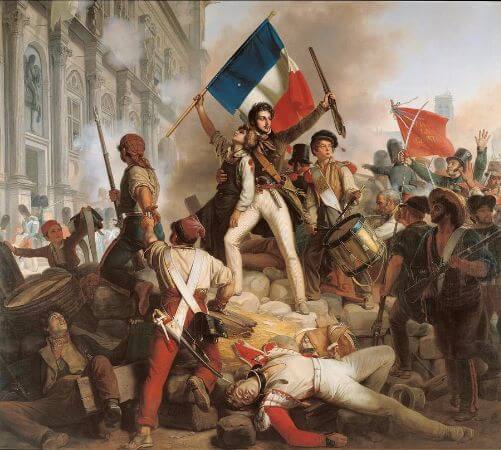
Side by side of the edited and original versions of Jean Victor Schnetz' Fighting At The Hotel De Ville (1830)
#French Kiss: Tale of the Revolution#final chapter#Chapter 20: Happy Endings#dukeceit#ts virgil#Virgil Gamin#ts remus#ts patton#ts janus#ts roman#Crown Prince Remus Capetian#Patton Cœur#Prince Roman Capetian#Janus Robespierre#demus#one-sided logicality#ambiguous ending#sanders sides fanfiction
22 notes
·
View notes
Note
We all know that Edward IV and Elizabeth Woodwell were very beautiful. Was there any record of praising their looks at that time?
Hi! Yes, of course. Contemporary and near-contemporary (mid-16th century) chronicles described their looks as well as personal qualities.
Philippe de Commines courtier serving the duke of Burgundy described Edward IV as handsome, affable, and energetic, "the handsomest prince my eyes ever beheld”.
The Croyland Chronicler described Edward as "a person of most elegant appearance and remarkable beyond all others for the attractions of his person."
Sir Thomas More records of Edward " He was a goodly personage and very princely to behold; of heart courageous, politic in counsel, in adversity nothing abashed, in prosperity rather joyful than proud, in peace just and merciful, in war sharp and fierce, in the field bold and hardy, and nevertheless no further than wisdom would, adventurous....He was of visage lovely; of body mighty, strong and clean made; howbeit in his latter days, with over liberal diet, somewhat corpulent and burly but nevertheless noy uncomely. He was in youth greatly given to fleshy wantoness, from which health of body in great prosperity and fortune, without a special grace, hardly refrains."
According to the Tudor historian Polydore Vergil, who was commissioned by Henry VII to write a history of England, Edward was ‘broad-shouldered’ and `his head and shoulders towered above those of nearly all other men’.
According to the chronicler Olivier de la Marche, Edward ‘was a handsome prince and had style’.
His skeleton, discovered during excavations in St George’s Chapel, Windsor in 1789, measured over six foot three.
Chronicles were also unanimous in their praise of Elizabeth Woodville's appearance.
Jean de Wavrin, Burgundian chronicler, called Elizabeth "the most beautiful woman in England".
Anonymous chronicler (who might have been one of Edward's servants) wrote that the king ‘could not perceive none of such constant womanhood, wisdom and beauty, as was Dame Elizabeth’
Dominic Mancini wrote that Edward had fallen in love with her because of her ‘beauty of person and charm of manner’
Sir Thomas More described her as ‘both faire, of a good favor, moderate of stature, well made and very wise’
Historian Edward Hall (mid-16th century) wrote that "she [Elizabeth] was a woman more of formal countenance, than of excellent beauty, but yet of such beauty and favour that with her sober demeanour, lovely looking, and feminine smiling (neither too wanton nor too humble), beside her tongue so eloquent, and her wit so pregnant, she was able to ravish the mind of a mean person, when she allured and made subject to her the heart of so great a King."
#edward iv#elizabeth woodville#history#15th century#wars of the roses#medieval#kings and queens#anonymous#ask
7 notes
·
View notes
Note
I've been reading over your posts about Hamilton's relationships with other Federalists of the time. What about Nicholas Fish? He came from an old New York family, he studied alongside Troup & Hamilton, served with Ham at Yorktown (he even made Trumbull's painting!), remained close to him the rest of his life, became the first Adjutant General of New York, may or may not have broken a girl's heart, and continued a line of illustrious Fishes. But beyond that...? Crickets.
Fish's and Hamilton's relationship seems to be one of the lesser known of Hamilton's notable friendships. Not much is known about their friendship due to only four letters of correspondence surviving (Likely burned by Fish for privacy), but they seemed to have had a life long friendship. And even after Hamilton's death, Fish remembered him as an honorable and beloved friend.
Nicholas Fish (1758-1833) was born into a relatively wealthy, New York, family. He attended Princeton but left before graduating to start studying law at King's College (Columbia University) through the office of John Morin Scott in New York. There he became interested in the organization of the Sons of Liberty (They were a loosely organized, clandestine - sometimes violent - political organization active in the colonies founded to advance the rights of the colonists and to fight taxation by the British government). Fish lived in New York City until 1774, then spent about a year in New Jersey before returning to New York in 1775.
During Hamilton's first months at King's, he and fellow classmate, Robert Troup, formed a club that gathered weekly for debating, writing, and speaking skills. The other members were; Fish, Edward Stevens, and Samuel and Henry Nicoll. Who were all relatively Hamilton's first and closests companions. The debates usually evolved around topics surrounding the brewing revolution, like monarchy and democracy. He also joined the volunteer militia group, The Hearts of Oak (Originally coined The Corsicans), alongside Hamilton and Troup. The students drilled before classes each morning in the churchyard of nearby St. Paul's Chapel. Their drillmaster was Edward Fleming, who had despite having served in a British regiment and married into the prominent De Peyster family but was still warmly attached to the American side. Fish once recalled;
Immediately after the Battle of Lexington, [Alexander Hamilton] attached himself to one of the uniform companies of militia then forming for the defence of the country by the patriotic young men of this city under the command of Captain Fleming, in which he devoted much time, attending regularly all the parades and performing tours of duty with promptitude and zeal.
Source — Alexander Hamilton, by Ron Chernow
In 1776 Fish was appointed by Brigadier General Scott aide-de-camp on his staff. On the 21st of August, 1776, Fish was appointed major of the 2nd New York Regiment. He served as a division inspector under Baron von Steuben in 1778. According to Fish, Hamilton had a direct hand in prodding Marquis de Lafayette to advocate bringing a French army to America. Before Admiral Jean Baptiste d’Estaing came with his fleet in July 1778, Hamilton encouraged Lafayette with ideas like having a French ground force with Lafayette as its commander. “The United States are under infinite obligations to [Lafayette] beyond what is known,” Hamilton told Fish later, “not only for his valour and good conduct as major general of our army, but for his good offices and infliuence in our behalf with the court of France. The French army now here [...] would not have been in this country but through his means.” [x]
He participated in the battles of Saratoga and Monmouth, in Sullivan's expedition against the Native Americans in 1779, and in the Virginia and Yorktown campaigns, in which he served for a time on the staff of Lafayette. Fish had shared a tent with Hamilton at Yorktown and recalled Hamilton bursting in gleefully after visiting Washington, hearing that he had won the coveted assignment, Hamilton hugged the surprised Major, shouting; “We have it! We have it!” [x] Although the two mostly went their separate ways during the war, Hamilton appointed Fish as his second-in-command. He commanded Hamilton's New York Battalion in the Assault on Redoubt 10 when Hamilton was given overall command of three battalions led by Gimat, Fish, and Laurens. To which, Hamilton was quite pleased about, writing to Eliza in August; “Major Fish is with me. I prize him both as a friend as an officer.” [x]
He is portrayed in the painting of the Surrender Of Lord Cornwallis, by Trumbull, standing behind Hamilton, Laurens, and Stuart.
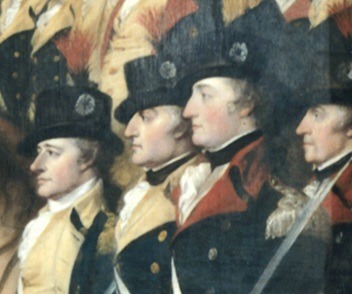

In the March of 1782, Hamilton and Eliza would have been trying to settle down in their first real home together in Albany, leaving the Schuyler Mansion where they had initially lived after Hamilton resigned from war. Hamilton wrote to Fish saying; “Send my horses by return of the bearer, unless they should be in too bad plight to travel. In this case, be so good as to put them out where they will be taken care of, and at the same time will not cost much for keeping.” [x]
In 1786, Fish was appointed Adjutant general of New York State, which he held for many years. Fish was also part of the Manumission Society, where many familiar faces were as well; Troup, Hamilton, Hercules Mulligan, William Livingston, John Rodgers, John Mason, James Duane, John Jay, and William Duer. The founding of the Manumission Society and antislavery societies in other states in the 1780s represented a hopeful moment in American race relations, right before the Constitutional Convention and the new federal government created such an overriding need for concord that even debating the divisive slavery issue could no longer be tolerated.
In 1794, he was appointed by Washington supervisor of the Federal revenue in New York City. In August, when the Hamiltons' then youngest son, John Church Hamilton, had fallen worryingly ill but started to recover—Hamilton sent his wife and child to New York City, where they remained under the watchful care Fish and Elisha Boudinot;
If you have not already left Albany write to me the precise day you will certainly leave it; so that I may meet you at New Ark. When you get to New York apply to Col Fish to make an arrangement for carrying you & the Child to New Ark & when there, go to Mr. Boudinot’s till I come.
Source — Alexander Hamilton to Elizabeth Hamilton, [August 21, 1794]
July 18, 1795, Hamilton was publicly criticized over his defense of the Jay Treaty at a meeting in New York. Hamilton tried to intervene in an argument between Commodore James Nicholson - who had smeared Hamilton months earlier - and Federalist lawyer, Josiah Ogden Hoffman. Nicholson was one of Hamilton's most prominent critics, and the two had long-standing political disagreements. When Hamilton came between the quarrel, Nicholson then allegedly called Hamilton an “Abettor of Tories” and accused him of declining a previous challenge to duel. “No man could affirm that with truth,” Hamilton retorted, and he “pledged himself to convince Mr. Nicholson of his mistake” by calling him to a duel at a more suitable time and place. [x] With Fish having drafted as his second, on the 20th he delivered the challenge letter to Nicholson;
The unprovoked rudeness and insult which I experienced from You on Saturday leaves me no option but that of a meeting with You, the object of which You will readily understand. I propose to You for the purpose Pawlus Hook as the place and monday next eleven o’clock as the time. I should not fix so remote a day but that I am charged with trusts for other persons which will previously require attention on my part. My friend Col. Fish who is to deliver You this will accompany me.
Source — Alexander Hamilton to James Nicholson, [July 10, 1795]
Nicholson immediately scratched out a reply, accepting the duel with that he would “certainly not decline your invitation” and asking that it take place the next morning; “The publicity of the affair & the unusual visit of your friend have however unfortunately occasioned an alarm in my family & may produce an inquiry—you will therefore perceive that my situation will be rendered extremely disagreeable unless our interview takes place before that time. I have therefore to intreat that it may not be postponed longer than tomorrow Morning.” [x] Eventually, on the 26th, after Hamilton and Nicholson had gone through three drafts of apologies (Hamilton being the one who wrote them for Nicholson's review), Nicholson signed a declaration apologizing for his conduct;
Mr. Nicholson declares that the warmth of the expressions which he recollects to have used to Mr. Hamilton proceeded from a misapprehension of the nature of his interposition in the altercation between Mr. Hoffman & Mr. Nicholson that as to the suggestion alleged to have been made by Mr. Nicholson namely that Mr. Hamilton had declined a former interview he does not recollect and is not conscious of having made it, neither did he intend the imputation which it would seem to imply and that if he did make the suggestion he regrets the pain which it must have occasioned to Mr. Hamilton.
Source — Drafts of Apology Required from James Nicholson, [25–26 July 1795]
The seconds representing Hamilton and Nicholson were DeWitt Clinton, Nicholas Fish, Rufus King, Brockholst Livingston. Once Nicholson and Hamilton agreed on the apology, they signed off on the following statement, thus ending the challenge in a “satisfactory and honorable way”.
In 1803, Fish married Elizabeth Stuyvesant (1775–1854), the daughter of Petrus Stuyvesant and Margaret Stuyvesant. They had five children together. On two separate occasions, Fish ran for United States Congress, and was unsuccessful. Losing to Samuel L. Mitchill in 1804 and Gurdon S. Mumford in 1806. In the week preceding Hamilton's mortal duel, Hamilton invited seventy people to the Grange for a lavish ball that included John Trumbull, Robert Troup, Fish, and William Short, Jefferson’s onetime secretary in Paris. John Church Hamilton recalls the event in his biographies of his father;
To reciprocate the attentions of his friends in a manner which, though novel here, he believed would most gratify, he gave, in the season of flowers and early fruits, a fete champetre. All that could please the modest taste of those simple days of wise frugality, was present. At distant points in the several copses were heard by sauntering groups the sounds of the horn and the clarionet, while his mansion was joyous with dances and repasts. On one of the piazzas were beheld some of his earliest, nearest friends, tracing the distant outlines of the variegated landscape of hill and dale, ocean and rivers; Hamilton standing by, chatting with Colonels Fish and Troup. Never was the fascination of his manner more remarked; gay or grave, as was the chanced topic, like the light and shade of a fine painting.
Source — Life of Alexander Hamilton, by John Church Hamilton · 1879
When the coming duel began to approach, on the 9th of July, Hamilton drafted his will at his last Manhattan town house. He named John B. Church, Fish, and Nathaniel Pendleton as executors;
In the Name of God Amen! I Alexander Hamilton of the City of New York Counsellor at Law do make this my last Will and Testament as follows. First I appoint John B Church Nicholas Fish and Nathaniel Pendleton of the City aforesaid Esquires to be Executors and Trustees of this my Will and I devise to them their heirs and Assigns, as joint Tenants and not as Tenants in common, All my Estate real and personal whatsoever and wheresoever upon Trust at their discretion to sell and dispose of the same, at such time and times in such manner and upon such terms as they the Survivors and Survivor shall think fit and out of the proceeds to pay all the Debts which I shall owe at the time of my decease, in whole, if the fund shall be sufficient, proportionally, if it shall be insufficient, and the residue, if any there shall be to pay and deliver to my excellent and dear Wife Elizabeth Hamilton.
Source — Last Will and Testament of Alexander Hamilton, [July 9, 1804]
Four years after Hamilton's death, Fish named his only son after his old college friend; Hamilton Fish (1808–1893), who served as New York Governor, United States Senator, and who married Julia Ursin Niemcewiez Kean (1816–1887).
Then again, Fish also twice ran unsuccessfully for Lieutenant Governor of New York. In 1810, he was the Federalist candidate, but lost to incumbent John Broome. Broome subsequently died one month into his term in August 1810. Fish ran in a special election for Lieutenant Governor in 1811 to fill the vacancy created by Broome's death, but lost to the then-mayor of New York City, DeWitt Clinton. During the War of 1812, Fish served as a member of the City Committee of Defense.
When Eliza was interviewing all the men that fought besides Hamilton to preserve his memory, Fish wrote a lengthy reminiscent letter to her in 1822, which I transcribed here (For whatever reason Tumblr keeps bugging out everytime I try to write it here).
Fish died in 1833, and was buried in the churchyard of St. Mark's Church in-the-Bowery in New York City.
Hope this helps.
#amrev#american history#american revolution#alexander hamilton#historical alexander hamilton#nicholas fish#history#queries#lookingforaham#cicero's history lessons
26 notes
·
View notes
Text

THE DESCRIPTION OF SAINT WILLIAM OF BOURGES (William of Donjeon) The Patron of the University of Paris and Gunsmiths Feast Day: January 10
St. William (also known as Guillaume de Donjeon) was born around 1140 in Nevers, France.
His father initially intended for Guillaume to join the army. However, Guillaume took the ecclesiastical way of life instead. His ecclesial tutoring was handled by his uncle, the Soissons archdeacon Pierre (Peter the hermit). William eventually abandoned worldly pursuits and joined the Order of Grandmont.
He stayed with the order for some time and followed their practices with immense dedication. When he discovered that the members were no longer cordial with each other, he left and joined the Cistercians. At the Pontigny Abbey in France, he donned the habit and was soon made Prior. He was appointed Abbot of Fontaine-Jean Abbey in 1184. Also in 1200, he was made abbot of Chaalis Abbey.
Saint William nurtured a genuine and true dedication to the Blessed Sacrament. For this reason, he was often at the altar, meditating on the true meaning of the Sacrament.
In 1200, William was appointed Archbishop of Bourges. He was reluctant to accept this new appointment because it meant abandoning his solitary life of meditation and prayer. Pope Innocent III, as well as other religious superiors, encouraged him to take the position. William agreed but continued his asceticism practices throughout the rest of his life. He always wore a shirt made from hair beneath his bishop's habit and completely gave up meat.
Bishop William oversaw the ongoing building of the Gothic Cathedral of Saint Stephen that had been started by his predecessor in 1195. He paid visits to the poor and sick regularly. He did not forget the imprisoned as well. He also stood up for the rights of the clerics against government intrusion.
Saint William of Bourges died in 1209 at midnight while meditating at the foot of the altar. He died at the age of 59. Before his death, he had been making plans to visit the Albigensians as part of his missionary work. In his will, he asked that his body be buried in ashes while wearing his hair shirt. His remains are currently interred in the Basilica reliquary chapel. Pope Honorius III declared the canonization of Saint William on May 17, 1218.
Saint William of Bourges is the patron saint of pregnant women, midwives, and people in difficult labor. His devotion to aiding women during childbirth and his deep compassion for those in pain earned him this special patronage. It’s a testament to his unwavering commitment to helping others and his enduring legacy in the realm of compassion and care.
St. William's life was intricately woven into the tapestry of the 12th century, a period marked by both religious fervor and intellectual enlightenment. His story is not only one of spiritual devotion but also a reminder of the dynamic and transformative era in which he lived, where faith and knowledge intertwined to shape the course of history.
Source: Saint of the Day
#random stuff#catholic#catholic saints#william of bourges#william of donjeon#guillaume de donjeon#guillermo de bourges#gunsmiths#university of paris
3 notes
·
View notes
Text

St. Jean chapel in Aubusson, La Marche region of France
French vintage postcard
#jean#historic#photo#briefkaart#vintage#region#marche#la marche#sepia#photography#carte postale#aubusson#postcard#postkarte#france#postal#tarjeta#ansichtskarte#french#old#st#ephemera#postkaart#chapel#la#st. jean
4 notes
·
View notes
Text

Poitiers
Poitiers est une ville de l'ouest de la France riche de ses ruelles médiévales, de ses nombreux parcs et églises ainsi que de son passé. On se perd agréablement à la recherche des façades anciennes, des hôtels particuliers et des chapelles romanes. Sa localisation pratique permet d'en faire une étape centrale pour un grand week-end dans le département.

Comment venir ?
Poitiers se situe :
en train : 30min de Tours, 1h20 de Paris, 1h45 de La Rochelle, 1h50 de Bordeaux, 2h de Limoges
en voiture : 1h de Tours, 1h30 de La Rochelle, 1h50 de Limoges, 2h d'Angers, 2h d'Orléans, 2h de Le Mans, 2h20 de Bordeaux
en bus : 1h50 de Tours, 2h25 de La Rochelle, 2h50 de Bordeaux

Quand et combien de temps ?
Poitiers est une ville à taille humaine qui se visite facilement en une journée. Cela vous laissera le temps de contempler les multiples églises du centre et de vous promener dans les parcs verdoyants. Pour rester sur place plus longtemps il faudra prévoir des expéditions dans les villes ou villages des environs.

Quoi voir à Poitiers ?
Des bâtiments historiques : place du Maréchal Leclerc, Hôtel de la Bidolière, Hôtel Fumé, Hôtel de ville, Hôtel Claveurier, Palais des Comtes de Poitou-Ducs d'Aquitaine, Amphithéâtre, Hôtel Jean Beaucé, Prévôt, Échevinage
Du patrimoine religieux : Eglise Notre-Dame-la-Grande, Cathédrale Saint-Pierre, Église Saint-Hilaire le Grand, Église Saint-Jean de Montierneuf, Église Saint-Paul, Église Saint-Porchaire, Église Sainte-Thérèse et Sainte Jeanne d'arc, Église Sainte-Radegonde, baptistère Saint-Jean, Eglise st germain, Eglise st hilaire le grand, Chapelle st louis
Des musées : Musée st croix, musée d'Histoire naturelle, musée du Palais des Comtes
Des parcs et jardins : parc de Blossac, jardin des plantes, parc floral de la Roseraie

Quoi faire dans les environs ?
Des villes et villages : Niort, Bourges, Tours, Chauvigny, Châtellerault, Saint-Savin-sur-Gartempe, La Roche-Posay, Angles-sur-l'Anglin, Parthenay, Montmorillon
Des lieux historiques : château à Moncontour, Église Saint-Hilaire de Melle, château de Thouars, Abbaye de Nouaillé-Mauperthuis, Abbaye de Saint Savin sur Gartempe
Des espaces verts : Laverré, Touffou, Jardin du château de La Mothe, La Guyonnière, Arboretum du chemin de la découverte, Vallée des singes, Grotte de Norée, Lac de St Cyr
Des activités ludiques : Futuroscope

crédits photos @lilstjarna
3 notes
·
View notes
Photo

Pinckney Retreat was an historic Lowcountry plantation. Originally named Retreat Plantation, this site sits on the banks of the great salt marsh in Beaufort SC.
Pinckney Retreat’s story is centuries old, a past as rich and fertile as the land itself. Near the bank sits the old Retreat Plantation home, a living monument to the story – one of love, war, survival and perseverance. Intended to last forever, the Tabby home was built in 1736 by dashing young French Huguenot, Jean de la Gaye, for his young bride Catherine Gautier. For the next 20 years, the happy couple enjoyed their home, entertaining each other nightly, she with her harp and he with his tales of the homeland.
After that, Retreat Plantation was owned by a series of legendary Lowcountry figures, including the Reverend Edward Tabb Walker, who built the framed Chapel of Ease on St. Helena Island. When the Civil War broke out, Reverend Walker fled with his wife and nine children to an area near Walterboro. One of Sherman’s soldiers discovered the Walker family bible hidden beneath the floorboards of the Retreat. Because it was the property of a minister, the hardened general decided not to burn the house and it remained unharmed.
Today the house remains in splendid condition with its 22-inch thick Tabby walls, original fireplaces, and rich hardwood planked floors. Built out of love by Jean de la Gaye to last forever, it is a living testament to strength, endurance, and Southern tradition.
2 notes
·
View notes
Text
Josephine Baker
French dancer and singer
Freda Josephine Baker, naturalised as Joséphine Baker, was an American-born French dancer, singer and actress. Her career was centered primarily in Europe, mostly in France.
Born: June 3, 1906, St. Louis, Missouri, United States
Died: April 12, 1975, University Hospitals Pitié Salpêtrière - Charles Foix, Paris
Children: Stellina Baker, Akio Bouillon, Brahim Baker, Jari Baker, MORE
Spouse: Jo Bouillon (m. 1947–1961), Jean Lion (m. 1937–1940)
Parents: Eddie Carson, Carrie McDonald
Siblings: Willie Mae Martin, Margaret Martin, Richard Martin

In September 1939, when France declared war on Germany in response to the invasion of Poland, Baker was recruited by the Deuxième Bureau, the French military intelligence agency, as an "honorable correspondent". Baker worked with Jacques Abtey, the head of French counterintelligence in Paris. She socialised with the Germans at embassies, ministries, night clubs, charming them while secretly gathering information. Her café-society fame enabled her to rub shoulders with those in the know, from high-ranking Japanese officials to Italian and Vichy bureaucrats, reporting to Abtey what she heard. She attended parties and gathered information at the Italian embassy without raising suspicion
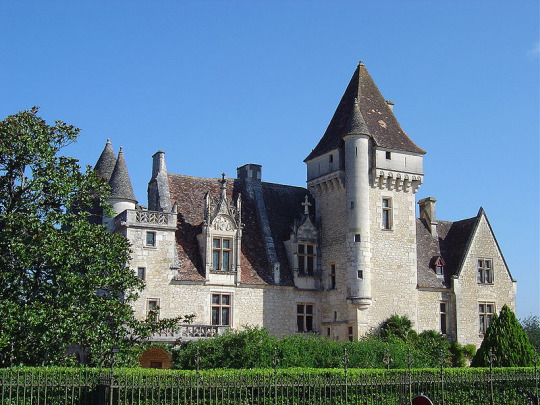
The Château des Milandes is a manor house in the commune of Castelnaud-la-Chapelle in the Dordogne département of France
In 1940, the entertainer Josephine Baker rented the château and then bought it in 1947. It has been listed as a monument historique by the French Ministry of Culture��since 1986
When the Germans invaded France, Baker left Paris and went to the Château des Milandes, her home in the Dordogne département in the south of France. She housed people who were eager to help the Free French effort led by Charles de Gaulle and supplied them with visas
Later years and death
In 1968, Baker lost her château owing to unpaid debts; afterwards Princess Grace offered her an apartment in Roquebrune, near Monaco.
Baker was back on stage at the Olympia in Paris in 1968
Baker was interred at Monaco's Cimetière de Monaco

Place Joséphine Baker in Paris
Place Joséphine Baker in the Montparnasse Quarter of Paris was named in her honor. She has also been inducted into the St. Louis Walk of Fame
and on March 29, 1995, into the Hall of Famous Missourians
St. Louis's Channing Avenue was renamed Josephine Baker Boulevard, and a wax sculpture of Baker is on permanent display at The Griot Museum of Black History.

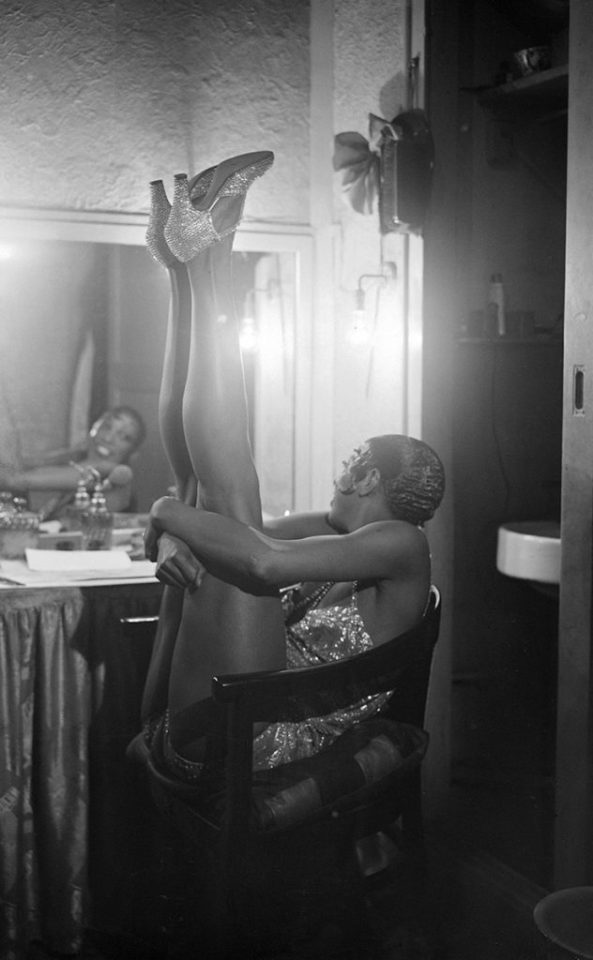
Josephine Baker in her dressing room at the Casino de Paris in Paris, 1931.
Photos by Boris Lipnitzki
7K notes
·
View notes